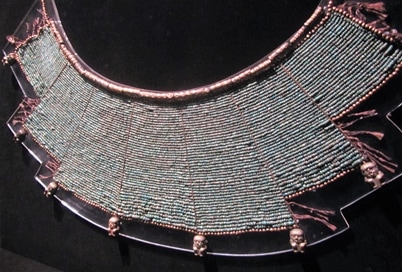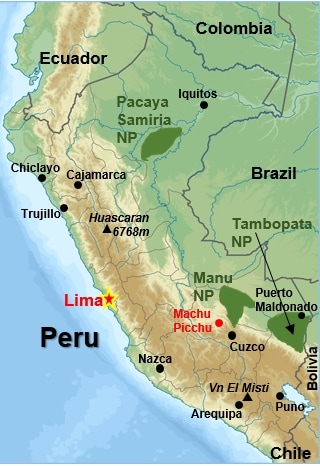Pre-Inca Civilisations - Ancient Cultures, Gold & Mysterious Lines
|
Pre-Inca Civilisations Whilst Peru's main visito site may be Machu Picchu and the Sacred Valley, displaying the might and glory of the Inca Empire in stunning natural surroundings, there are many other outstanding sites of antiquity to be seen and enjoyed in Peru, yet rarely visited. These are found along the narrow coastal region of Peru, where the first great civilisations were established. These included the great Moche and Chimu cultures in NW Peru near Chiclayo and Trujillo respectively, and the Nazca culture in the south. ANOTHER "NEW" pre-Inca destination is now also being developed, at Kuélap, near modern day Chachapoyas. For MORE see BELOW! |
|
Whilst hunting tools dating back 11,000 years have been found in Peru, the first known city and civilisation in the Americas was Caral, located some 200 kms north of modern-day Lima, near Barranca. This was the capital and principal religious centre for the Norte Chico culture (2,500BC), from which subsequent civilisations took root. It is considered to be one of the 6 founding civilisations of the ancient world, being formed 1000 years after the Sumerian civilisation first appeared in Mesopotamia; existing in parallel with the time of the great pharaohs in ancient Egypt, and pre-dating the famous Olmecs of Meso-America by 2000 years.
|
Nazca, Moche & Chimu Cultures
Principal amongst the subsequent cultures to gain prominence in Peru were the fascinating Nazca people (200 BC - 600 AD) near Ica in southwest Peru, most famous for their colossal line drawings on the flat desert plains. Later, the Moche civilisation (100 - 800 AD) near Chiclayo became predominant, with their fine pottery but cruel ceremonial deeds; and then their successors the Chimu (850 -1470 AD) in nearby Trujillo, famed for the skills of their artisans. However the weather, especially the El Nino effect causing floods and droughts, would result in the waning of these coastal powers, leaving the inland cultures such as the Tiwanaku and Wari to flourish. In turn all these were to be defeated or absorbed by the mighty Incas until the arrival of the Spanish Conquistadors in 1532.
Principal amongst the subsequent cultures to gain prominence in Peru were the fascinating Nazca people (200 BC - 600 AD) near Ica in southwest Peru, most famous for their colossal line drawings on the flat desert plains. Later, the Moche civilisation (100 - 800 AD) near Chiclayo became predominant, with their fine pottery but cruel ceremonial deeds; and then their successors the Chimu (850 -1470 AD) in nearby Trujillo, famed for the skills of their artisans. However the weather, especially the El Nino effect causing floods and droughts, would result in the waning of these coastal powers, leaving the inland cultures such as the Tiwanaku and Wari to flourish. In turn all these were to be defeated or absorbed by the mighty Incas until the arrival of the Spanish Conquistadors in 1532.
|
|
Nazca Culture
The Nazca culture flourished from 100BC - 800AD in the Ica valley of SW Peru. Largely agricultural, they also developed sophisticated pottery skills and complex fabric design, and built a system of underground aqueducts that function to this day. Also a complex social and religious people, this is depicted in their exquisite pottery and material artefacts, as can be seen in the excellent Museum of Larco in Lima. They also collected human "trophy heads" for ceremonial use or as evidence of prowess in battle. Their overarching legacy is the mysterious "Nazca Lines", geoglyphs of colossal geometric design that cover the dry desert plains in the Nazca valley. To visit the Lines, stay at Ica or in Nacza itself, and hire a light aircraft to fly over the Lines*. (* From US$ 80/person for 2 hour flight). |
|
|
Moche Culture
The Moche culture dominated in NW Peru, near modern-day Chiclayo, between 100 - 800AD. An agricultural economy, their social structure was based on religious ceremony, with strictly structured elite and commoner levels. Their cities were always dominated by two monumental religious pyramids (huacas), and their murals and extravagantly worked ceramics and metallurgy (gold and silver) indicated their focus on war, metalwork, weaving and sex! In addition, there is evidence of ritual torture and human sacrifice, using the crescent-shaped tumi knife in ceremonial acts. The intact royal tomb at Sipan containing the remains of a high ranking male, the "Lord of Sipan", has transformed our understanding of the culture. |
|
|
Chimu Culture
The Chimú (900 - 1470 AD) are known for their distinctive monochromatic pottery and fine metallurgy (copper, silver, bronze, gold), existing in the Moche Valley near modern-day Trujillo. Emerging from the earlier Moche civilisation, they were fervent worshippers of the Moon (unlike the Moche and Incas, who worshipped the Sun). Whilst the Chimu also had an agricultural economy, developing complex irrigation systems to link and supply valleys, their principal income was based on the superb skills of their thousands of specialist artisans. At their height Chan Chan, their capital close by Trujillo, had an estimated 12,000 or more artisans labouring on fine products, a site well worth visiting today. |
Kuélap - the NEW destination to rival Machu Picchu!!
The Chachapoyas culture - Warriors of the Clouds"!
|
|
Presented here and on the Machu Picchu/Sacred Valley pages, Kuélap stems from a time BEFORE the Inca Empire, yet may SOON vie with Machu Picchu to become the TOP destination in Peru! This has been achieved by the construction of a new cable car system in March 2017, that has opened up this previously "lost city" and its surrounds to world tourism. Founded around 600 AD until the Incas toppled the culture in a gruesome massacre in the late 1470s, at its peak Kuélap was a vibrant city of some 3,000 souls; one of the largest cities in the known world! Based on the Cachachapoyas culture, these people were also known as the "Warriors of the Clouds".
|
|
|
Accommodation
Trujillo: Good 3 and 4-star hotels can be found in Trujillo, within 5kms of the Chimu Chan Chan site. Prices** range from US$ 100 -120/room/night in a 4* option; and between US$ 50-90/room/night in a 3* hotel. Chiclayo: A similar range can be found in Chiclayo, some 12kms from the Moche Royal Tombs of Sipan site, for a slightly smaller fee. Prices** range from US$ 80 - 100/room/night in a 4* option; and between US$ 50-80/room/night in a 3* hotel. City centre sites attract the higher figures. |
|
|
Ica & Paracas: For visitors keen to observe the Nazca Lines, some guests stay in Nazca township itself, some 2 hours on from Ica, but only 2/3* hotels are on offer. Here they purchase early AM flights to view the lines. A great ALTERNATIVE is to stay in Ica (town, or lovely Paracas Beach, or the equally fascinating Huaca China Oasis), where you can also catch flights to the Nazca Lines, can visit the nearby, marine-life rich Ballestas Islands, and also conduct Dune Buggy and Sandboarding activities!
Prices** range from US$ 180 - 250/room/night in a 4* Paracas Beach option; between US$80/90/room/night in a 3* Huaca China Oasis option; or some US$ 70-80/room/night in a 3* hotel in Ica city centre. (**) Pricing (2022) based on 2 persons sharing, B & B, medium season |


